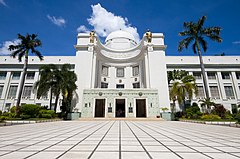Cebu Provincial Capitol
| Cebu Provincial Capitol | |
|---|---|
| Kapitolyo sa Sugbo | |

Facade of Cebu Provincial Capitol
|
|
| General information | |
| Architectural style | Neoclassicism, art deco |
| Location | Cebu City, Philippines |
| Coordinates | 10°19′0.11″N 123°53′26.74″E / 10.3166972°N 123.8907611°ECoordinates: 10°19′0.11″N 123°53′26.74″E / 10.3166972°N 123.8907611°E |
| Current tenants | Office of the Governor Provincial Government of Cebu |
| Construction started | 1937 |
| Completed | 1938 |
| Inaugurated | June 14, 1938 |
| Technical details | |
| Structural system | Reinforced concrete |
| Floor count | 3 floors at the main block; 2 at the secondary wings |
| Design and construction | |
| Architect | Juan Marcos Arellano y De Guzmán (1888-1960) |
| Civil engineer | Pedro Siochi y Angeles (1886-1951) |
| Main contractor | the Pedro Siochi and Company |
The Cebu Provincial Capitol is the seat of the provincial government of Cebu in the Philippines. Located at the north end of Osmeña Boulevard in Cebu City, it was designed by Juan M. Arellano, a Filipino architect best known for the Manila Metropolitan Theater (1935), the Legislative Building (1926; now the National Museum of the Philippines), and the Manila Central Post Office (1926). An inscription on the central concave portion of its façade reads, "The authority of the government emanates from the people. Erected A.D. MCMXXXVII."
It is also the same venue, which held the second inauguration of President Gloria Macapagal Arroyo in June 2004.
Planning for the capitol, which was to replace the old Casa Provincial in the city's Spanish quarter, actually started in 1910, in the day of the inauguration of Osmeña Waterworks. Sergio Osmeña, then Speaker of the First Philippine Assembly, took Governor General William Cameron Forbes to an exhibition baseball match, after which they inspected the future site of the building near Fuente Osmeña. In the book about his father E. J. Hanselma: Colonial Engineer, James Hanselma narrates the event:
Construction commenced in 1937 under the supervision of the engineering firm Pedro Siochi and Company. It took place also during the administration of Governor Sotero Cabahug who was its principal champion. It was financed through a bond approved by Pres. Manuel Quezon and through public subscription. The building was finally completed in 1938 during the term of Governor Buenaventura Rodriguez, the inauguration ceremony taking place during June 14, 1938, led by President Manuel L. Quezon, with Cebu Archbishop Gabriel Reyes blessing the new building, and the wife of Governor Rodriguez breaking the champagne bottle at the main balcony.
The Capitol was badly damaged in World War II but eventually rehabilitated through the Tydings War Damage Act of 1946.
The Cebu Provincial Capitol is dramatically positioned at the end of a grand perspective of a new avenue (Osmeña Boulevard) as conceived by William E. Parsons in his 1912 plan of Cebu, in the lines of the City Beautiful Movement.
...
Wikipedia
